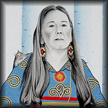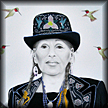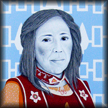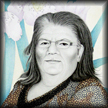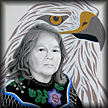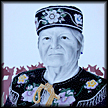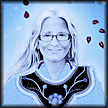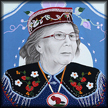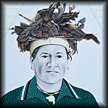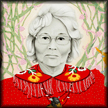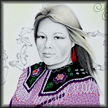A long neglected and misunderstood area of American Indian art has been the beadwork produced by the first nations of the Northeast Woodlands. Although the interest and appreciation for this work has escalated in recent years, there are still many outside the Native community who are unfamiliar with the historical context and currents that contributed to the emergence of this type of Native American artistry. Beginning in the early 1800s, Native beadworkers created a new art form: delicate, intricately beaded hats, purses, and other fanciful objects, often called “whimsies,” that were made to be sold as souvenirs. This practice was not merely a response to the exotic needs of Victorian patrons as it also represented a stratagem of subsistence, cultural resistance and continuance.
Historically, beadwork has been described as a kindred undertaking that was performed when family members gathered. As they worked in a communal setting, Native beadworkers thoughtfully wove stories into their designs, which told of what it meant to be Haudenosaunee (Iroquois) or Wabanaki.
In 2006, in an effort to raise public awareness, I produced the original Made of Thunder, Made of Glass: American Indian Beadwork of the Northeast exhibit which travelled to four museums. The exhibit featured both a world class collection of historical beadwork in conjunction with a series of contemporary paintings I produced of people from the Indian Nations who created the beadwork in the exhibit.
When the Made of Thunder exhibit came to an end in the summer of 2009, I began planning for a complementary exhibit – a series of portraits of present-day Native beadworkers to showcase them and their artistry. The creators of this work are today’s culture bearers of their respective Nations and the people best suited to tell their story. It’s a Native perspective that adds to our understanding of the material and how the beadwork affects them as artists and as a community. When I began this latest series of portraits it was to raise awareness about the continuing traditions in Northeast Woodland beadwork. So I’m excited to announce that both Memorial Hall Museum and the Castellani Museum of Art will exhibit them in 2015 and 2016. The exhibit will feature a collection of antique bags, hats, moccasins and “whimsies,” to create a zone where curiosity can expand and conversations be had about this area of American Indian art. One of the highlights of the new show will be a selection of contemporary beadwork from the artists whose portraits will be on exhibit. These artists are from the same Nations that created the antique pieces. The exhibit will be a fusion of fine art and fine Native craft and the project will underscore the harmony between the artists, nature, their inspiration and their artwork.
It’s important to know that many contemporary Northeast Woodland artists are not reviving or reintroducing an ancient art form; rather several communities are part of the vital continuance of an unbroken tradition. On the surface, these pieces are the canvas upon which artists display their technical skills and artistic vision. But below the surface, the power inherent in a beautiful object is a central feature of life. Beadwork continues to be a language through which artists express their deepest beliefs about the universe. We may never know the full extent of the meanings contained in the historic pieces, but imbedded within the designs are stories of a people told in symbols and motifs that reflect a sacred relationship with the natural world. Many of the old stories are lost now, but the beadwork survives and the traditions live on, testifying to the inventiveness and sense of beauty of an exceptional and laudable people.
As artists we have to take responsibility for cultural preservation and to promote and protect Native arts. It’s towards this end that the project is focused.
The exhibit will open in 2015 at Memorial Hall Museum in Deerfield, Massachusetts and will travel to the Castallani Museum of Art in Niagara Falls, New York in 2016.
Click on any of the buttons to learn more about the individual artists in the exhibit.
